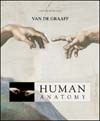 |  Human Anatomy, 6/e Kent Van De Graaff,
Weber State University
Articulations
Chapter SummaryClassification of Joints
- Joints are formed as
adjacent bones articulate. Arthrology is the science concerned with the study
of joints; kinesiology is the study of movements involving certain joints.
- Joints are classified
as fibrous, cartilaginous, or synovial.
Fibrous Joints - Articulating bones in
fibrous joints are tightly bound by fibrous connective tissue. Fibrous joints
are of three types: sutures, syndesmoses, and gomphoses.
- Sutures are found only
in the skull; they are classified as serrate, lap, or plane.
- Syndesmoses are found
in the vertebral column, middle ear, antebrachium, and leg. The articulating
bones of syndesmoses are held together by interosseous ligaments, which permit
slight movement.
- Gomphoses are found only
in the skull, where the teeth are bound into their sockets by the periodontal
ligaments.
Cartilaginous Joints
- The fibrocartilage or
hyaline cartilage of cartilaginous joints allows limited motion in response
to twisting or compression. The two types of cartilaginous joints are symphyses
and synchondroses.
- The symphysis pubis and
the joints formed by the intervertebral discs are examples of symphyses.
- Some synchondroses are
temporary joints formed in the growth plates between the diaphyses and epiphyses
in the long bones of children. Other synchondroses are permanent; for example,
the joints between the ribs and the costal cartilages of the rib cage.
Synovial Joints - The freely movable synovial
joints are enclosed by joint capsules that contain synovial fluid. Synovial
joints include gliding, hinge, pivot, condyloid, saddle, and ball-and-socket
types.
- Synovial joints contain
a joint cavity, articular cartilages, and synovial membranes that produce
the synovial fluid. Some also contain articular discs, accessory ligaments,
and associated bursae.
- The movement of a synovial
joint is determined by the structure of the articulating bones, the strength
and tautness of associated ligaments and tendons, and the arrangement and
tension of the muscles that act on the joint.
Movements at Synovial
Joints - Movements at synovial
joints are produced by the contraction of the skeletal muscles that span the
joints and attach to or near the bones forming the articulations. In these
actions, the bones act as levers, the muscles provide the force, and the joints
are the fulcra, or pivots.
- Angular movements increase
or decrease the joint angle produced by the articulating bones. Flexion decreases
the joint angle on an anterior-posterior plane; extension increases the same
joint angle. Abduction is the movement of a body part away from the main axis
of the body; adduction is the movement of a body part toward the main axis
of the body.
- Circular movements can
occur only where the rounded surface of one bone articulates with a corresponding
depression on another bone. Rotation is the movement of a bone around its
own axis. Circumduction is a conelike movement of a body part.
- Special joint movements
include inversion and eversion, protraction and retraction, and elevation
and depression.
- Synovial joints and their
associated bones and muscles can be classified as first-, second-, or third-class
levers. In a first-class lever, the fulcrum is positioned between the effort
and the resistance. In a second-class lever, the resistance lies between the
fulcrum and the effort. In a third-class lever, the effort is applied between
the fulcrum and the resistance.
Specific Joints of the
Body - The temporomandibular
joint, a combined hinge and gliding joint, is of clinical importance because
of temporomandibular joint (TMJ) syndrome.
- The glenohumeral (shoulder)
joint, a ball-and-socket joint, is vulnerable to dislocations from sudden
jerks of the arm, especially in children before strong shoulder muscles have
developed.
- There are two sets of
articulations at the elbow joint as the distal end of the humerus articulates
with the proximal ends of the ulna and radius. It is a hinge joint that is
subject to strain during certain sports.
- The metacarpophalangeal
joints (knuckles) are condyloid joints, and the interphalangeal joints (between
adjacent phalanges) are hinge joints.
- The ball-and-socket coxal
(hip) joint is adapted for weight bearing. Its capsule is extremely strong
and is reinforced by several ligaments.
- The hinged tibiofemoral
(knee) joint is the largest, most vulnerable joint in the body.
- There are two hinged
articulations within the talocrural (ankle) joint. Sprains are frequently
associated with this joint.
|
|



 2002 McGraw-Hill Higher Education
2002 McGraw-Hill Higher Education

 2002 McGraw-Hill Higher Education
2002 McGraw-Hill Higher Education